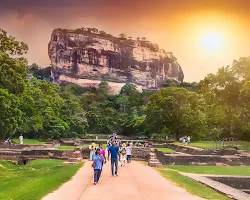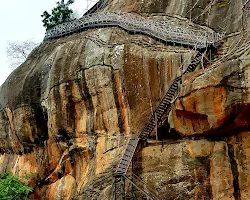Sigiriya, often referred to as the “Lion Rock,” stands as an awe-inspiring testament to the harmonious fusion of natural beauty and cultural heritage. Located in the heart of Sri Lanka, this ancient rock fortress has captivated the imagination of travelers, historians, and art enthusiasts alike for centuries. Its multifaceted significance lies in its breathtaking natural surroundings, architectural brilliance, and rich historical context, making it a true marvel that seamlessly blends nature and culture.
architectural brilliance, and rich historical context, making it a true marvel that seamlessly blends nature and culture.
Nestled within the verdant landscapes of central Sri Lanka, Sigiriya exudes an enchanting beauty that immediately arrests the senses. The surrounding lush forests, picturesque water gardens, and serene lotus-filled ponds create an idyllic setting that complements the imposing rock structure. The rock itself, rising abruptly from the ground, creates a dramatic spectacle against the backdrop of the clear blue sky. Its geological formation, characterized by rugged cliffs and crevices, adds an air of mystery and intrigue to the site. The symphony of colors that paints the landscape during sunrise and sunset, as well as the panoramic views from the summit, further accentuate Sigiriya’s natural allure.
At the heart of Sigiriya’s cultural significance is its intricate architectural layout, which showcases the ingenuity and engineering prowess of ancient civilizations. The fortress complex is a masterpiece of urban planning, with a meticulous arrangement of gardens, terraces, and pathways. The ingenious hydraulic system that once powered fountains and water features demonstrates an advanced understanding of engineering and aesthetics. The crowning glory is the frescoes that adorn the rock’s western face, depicting celestial maidens known as “Sigiriya Frescoes.” These paintings, known for their vibrant colors and delicate detailing, offer a glimpse into the artistic skills of the past and provide a connection to the cultural values of the time.
their vibrant colors and delicate detailing, offer a glimpse into the artistic skills of the past and provide a connection to the cultural values of the time.
Historical roots can be traced back to the 5th century AD, during the reign of King Kasyapa. The rock fortress served as both a royal residence and a strategic military stronghold. King Kasyapa’s ambitious endeavor to create a utopian city atop Sigiriya reflects the power dynamics and societal aspirations of ancient Sri Lanka. The surrounding landscapes, including the remains of fortifications, gardens, and reservoirs, offer valuable insights into the political and social structures of the past. Furthermore, the site’s association with Buddhism, evident through the presence of monastic dwellings and inscriptions, highlights the religious and spiritual dimensions of Sigiriya’s cultural heritage.
Recognition as a UNESCO World Heritage Site has played a pivotal role in its preservation and promotion. Efforts to conserve the site’s natural and cultural attributes have been undertaken, ensuring that future generations can continue to experience its splendor. The delicate balance between maintaining the site’s integrity and accommodating the influx of tourists is an ongoing challenge. Sustainable tourism practices, guided tours, and visitor education initiatives have been implemented to mitigate the potential impact on the site’s fragile ecosystem and heritage.
initiatives have been implemented to mitigate the potential impact on the site’s fragile ecosystem and heritage.
In the tapestry of human history, Sigiriya stands as a remarkable synthesis of natural beauty and cultural heritage. Its majestic presence against the backdrop of Sri Lanka’s lush landscapes is a testament to the interconnectedness between man and nature. The architectural grandeur and historical depth of Sigiriya underscore the enduring legacy of human creativity and perseverance. As travelers and scholars continue to explore its depths, Sigiriya remains an enduring symbol of the remarkable capacity of civilizations to leave an indelible mark on the world, seamlessly blending the wonders of nature with the genius of human ingenuity
The Sigiriya Rock Fortress was built by King Kassapa I, who ruled over Sri Lanka from 477 to 495 AD. The king chose the site for his palace because of its natural defenses, with the high rock providing a secure and easily defensible location. The palace and fortifications were built over a period of several years, and King Kassapa I is said to have lived there for 18 years. After his death, the site was abandoned and fell into disuse.
Visitors to the Sigiriya Rock Fortress can explore the site’s many well-preserved ruins and enjoy the breathtaking views from the top of the rock. The climb to the top of the rock takes visitors through a series of well-preserved ruins, including the palace, gardens, and fortifications. The most famous feature of the site is the Lion Rock entrance, which used to stand at the base of the rock and was once the entrance to the palace. Today, only the paws of the lion statue remain, but the entrance is still an impressive sight.
The palace ruins at the top of the rock offer visitors a glimpse into the life of King Kassapa I and his court. The site features several well-preserved walls and foundations, as well as the remains of a moat, palace walls, and several large pools. Visitors can also explore the Sigiriya Frescoes, ancient paintings that once adorned the walls of the palace. The frescoes depict images of women and are considered some of the earliest examples of Sri Lankan paintings.
Gardens and Water Management Systems
One of the most impressive features of the Sigiriya Rock Fortress is its sophisticated water management system, which includes a series of pools, channels, and fountains. The site also features several well-preserved terraced gardens, which were once used to grow crops and provide food for the palace residents. These gardens are considered some of the earliest examples of terraced agriculture in Sri Lanka and are still in use today, with crops grown on the terraces providing food for local communities.
channels, and fountains. The site also features several well-preserved terraced gardens, which were once used to grow crops and provide food for the palace residents. These gardens are considered some of the earliest examples of terraced agriculture in Sri Lanka and are still in use today, with crops grown on the terraces providing food for local communities.
It is an impressive and well-preserved example of ancient urban planning and engineering. Visitors to the site can explore the ruins of the palace, fortifications, and gardens, and learn about the history and culture of Sri Lanka. Whether you’re a history buff, a nature lover, or just looking for a breathtaking view, Sigiriya Rock Fortress is a must-visit destination in Sri Lanka.

OURA Travel operates with the utmost dedication to offering exceptional experiences. While we endeavor to ensure accurate and enjoyable tours, our services are subject to availability and may change without prior notice. We bear no liability for unforeseen circumstances, injuries, or loss during the tours. Booking confirmation is contingent upon availability and adherence to our specific booking conditions, including terms and cancellation policies. Participants are advised to meet health requirements for travel, as we disclaim liability for issues arising from health or fitness limitations. Additionally, our descriptions are aimed at accuracy, although errors may occur, and we reserve the right to rectify any information or pricing inaccuracies.